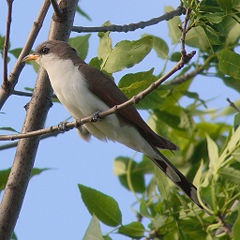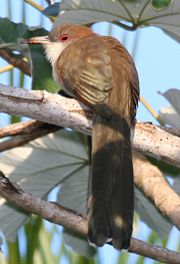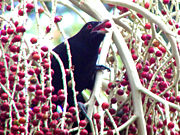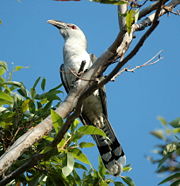Cuckoo
| Cuckoos | ||||||||||
|---|---|---|---|---|---|---|---|---|---|---|
 Yellow-billed Cuckoo (Coccyzus americanus)
|
||||||||||
| Scientific classification | ||||||||||
|
||||||||||
| Genera | ||||||||||
|
Around 26, see text. |
The cuckoos are a family, Cuculidae, of near passerine birds. The order Cuculiformes, in addition to the cuckoos, also includes the turacos (family Musophagidae, sometimes treated as a separate order, Musophagiformes). Some zoologists and taxonomists have also included the unique Hoatzin in the Cuculiformes, but its taxonomy remains in dispute. The cuckoo family, in addition to those species named as such, also includes the roadrunners, koels, malkohas, couas, coucals and anis. The coucals and anis are sometimes separated as distinct families, the Centropodidae and Crotophagidae respectively.
The cuckoos are generally medium sized slender birds. The majority are arboreal, with a sizeable minority that are terrestrial. The family has a cosmopolitan distribution, with the majority of species being tropical. The temperate species are migratory. The cuckoos feed on insects, insect larvae and a variety of other animals, as well as fruit. Many species are brood parasites, laying their eggs in the nests of other species, but the majority of species raise their own young.
Contents |
Morphology

Cuckoos are medium sized birds that range in size from the Little Bronze Cuckoo, at 17 g and 15 cm (6 inches), to the Channel-billed Cuckoo, at 630 g (1.4 lbs) and 63 cm (25 inches).[1] There is generally little sexual dimorphism in size, but in the species that are it can be either the male or the female that is larger. One of the most important distinguishing features of the family are the feet, which are zygodactyl, meaning that the two inner toes pointed forward and the two outer backward. There are two basic body forms, arboreal species (like the Common Cuckoo) which are slender and have short tarsi, and terrestrial species (like the roadrunners) which are more heavy set and have long tarsi. Almost all species have long tails which are used for steering in terrestrial species and as a rudder during flight in the arboreal species. The wing shape also varies with lifestyle, with the more migratory species like the Black-billed Cuckoo possessing long narrow wings capable fo strong direct flight, and the more terrestrial and sedentary cuckoos like the coucals and malkohas having shorter rounded wings and a more laboured gliding flight.
The subfamily Cuculinae are the brood-parasitic cuckoos of the Old World.[1] They tend to conform to the classic shape, with (usually) long tails, short legs, long narrow wings and an arboreal lifestyle. The largest species, the Channel-billed Cuckoo, also has the most outsized bill in the family, resembling that of a hornbill. The subfamily Phaenicophaeinae are the non-parasitic cuckoos of the Old World, and include the couas, malkohas, and ground-cuckoos. They are more terrestrial cuckoos, with strong and often long legs and short rounded wings. The subfamily typically has brighter plumage and brightly coloured bare skin around the eye. The coucals are another terrestrial subfamily of long tailed long legged and short winged cuckoos. They are large heavyset birds with the largest, the Greater Black Coucal, being around the same size as the Channel-billed Cuckoo. The subfamily Coccyzinae are arboreal and long tailed as well, with a number of large insular forms. The typical ground-cuckoos are similar to the Asian ground-cuckoos in being long legged and terrestrial, and includes the long billed roadrunner which can reach speeds of 30 km/h when chasing prey. The final subfamily are the atypical anis, which include the small clumsy anis and the larger gurias. The anis have massive bills and smooth glossy feathers.


The feathers of the cuckoos are generally soft, and often becomes waterlogged in heavy rain. Cuckoos will often sun themselves after rain, and the anis will hold their wings open in the manner of a vulture or cormorant while drying. There is considerable variation in the plumage exhibited by the family. Some species, particularly the brood parasites have cryptic plumage, whereas others have bright and elaborate plumage. This is particularly true of the Chrysococcyx or glossy cuckoos, which have iridescent plumage. Some cuckoos have a resemblance to hawks with barring on the underside, this apparently alarms potential hosts which allows the female to access a host nest .[2] The young of some brood parasites are coloured so as to resemble the young of the host. For example, the Common Koels breeding in India have black offspring to resemble their crow hosts, whereas in Australia the chicks are brown like the honeyeater hosts. Sexual dimorphism in plumage is uncommon in the cuckoos, being most common in the parasitic Old World species.
Cuckoo genera differ in the number of primary wing feathers as below.
- Phaenicophaeus, Coccyzus, Piaya - 9
- Cuculus - 9 or 10
- Pachycoccyx, Clamator levaillantii, Centropus - 10
- Microdynamis, Eudynamys,Clamator glandarius - 11
- Some coucals - 12
- Scythrops novaehollandiae - 13
Distribution and habitat

The cuckoos have a cosmopolitan distribution, ranging across all the world's continent except Antarctica. They are absent from the south west of South America, the far north and north west of North America, and the driest areas of the Middle East and North Africa (although they occur there as passage migrants). They generally only occur as vagrants in the oceanic islands of the Atlantic and Indian Oceans, but one species breeds on a number of Pacific islands and another is a winter migrant across much of the Pacific.[3]
The Cuculinae is the most widespread subfamily of cuckoos, and is distributed across Europe, Asia, Africa, Australia and Oceania. Amongst the Phaenicophaeinae cuckoos the malkohas and Asian ground-cuckoos are restricted to southern Asia, the couas are endemic to Madagascar and the Yellowbill widespread across Africa. The coucals are distributed from Africa through tropical Asia down into Australia and the Solomon Islands. The remaining three subfamilies have a New World distribution, all three are found in both North and South America. The Coccyzinae reaches the furthest north of the three subfamilies, breeding in Canada, whereas the anis reach as far north as Florida and the typical ground-cuckoos the south west United States.
For the cuckoos suitable habitat provides a source of food (principally insects and especially caterpillars) and a place to breed, for brood parasites the need is for suitable habitat for the host species. Cuckoos occur in a wide variety of habitats. The majority of species occur in forests and woodland, principally in the evergreen rainforests of the tropics. Some species inhabit or are even restricted to mangrove forests, these include the Little Bronze-cuckoo of Australia, some malkohas, coucals, and the aptly named mangrove Cuckoo of the New World. In addition to forests come species of cuckoo occupy more open environments, this can include even arid areas like deserts in the case of the Greater Roadrunner or the Pallid Cuckoo. Temperate migratory species like the Common Cuckoo inhabit a wide range of habitats in order to make maximum use of the potential brood hosts, from reed beds (where they parasitise Reed Warblers), to treeless moors (where they parasitise Meadow Pipits).
Migration
Most species of cuckoo are sedentary, but several species of cuckoo undertake regular seasonal migrations, and several more undertake partial migrations over part of their range. The migration may be diurnal, as in the Channel-billed Cuckoo, or nocturnal, as in the Yellow-billed Cuckoo. For species breeding at higher latitudes food availability dictates that they migrate to warmer climates during the winter, and all do so. The Long-tailed Cuckoo which breeds in New Zealand flies migrates to its wintering grounds in Polynesia, Micronesia and Melanesia a feat described as "perhaps the most remarkable overwater migration of any land bird";[4] and the Yellow-billed Cuckoo and Black-billed Cuckoo breed in North America and fly across the Caribbean Sea, a non-stop flight of 4000 km. Other long migration flights include the Lesser Cuckoo, which flies from India to Kenya across the Indian Ocean (3000 km) and the Common Cuckoos of Europe which fly non-stop over the Mediterranean Sea and Sahara Desert on their voyage to southern Africa. Within Africa 10 species make regular intra-continental migrations that are described as polarised, that is they spend the non-breeding season in the tropical centre of the continent and move north and south to breed in the more arid and open savannah and deserts.[5] This contrasts with the situation in the Neotropics, where no species have this migration pattern, or tropical Asia, where a single species does. 83% of the Australian species are partial migrants within Australia or travel to New Guinea and Indonesia after the breeding season.[6]
Behaviour
The cuckoos are for the most part solitary birds that seldom occur in pairs or as part of groups. The biggest exception to this are the anis of the Americas which have evolved cooperative breeding and other social behaviours. For the most part the cuckoos are also diurnal as opposed to nocturnal, but many species will call at night (see below). The cuckoos are also generally a shy and retiring family, more often heard than seen. The exception to this are again the anis, which are often extremely confiding towards humans and other species.
Feeding

Most cuckoos are insectivorous; and in particular are specialised in eating larger insects and caterpillars, including noxious hairy types avoided by other birds. They are unusual amongst birds in processing their prey prior to swallowing, rubbing it back and forth on hard objects such as branches and then crushing it with special bony plates in the back of the mouth.[7] They will also take a wide range of other insects and animal prey. The lizard-cuckoos of the Caribbean have, in the relative absence of birds of prey, specialised in taking lizards. Larger, ground types such as coucals and roadrunners also feed variously on snakes, lizards, small rodents, and other birds, which they bludgeon with their strong bills. The parasitic cuckoos are generally not recorded as participating in mixed-species feeding flocks, although some studies in eastern Australia found several species would participate in the non-breeding season, but were mobbed and unable to do so in the breeding season.[8] Ground-cuckoos of the genus Neomorphus are sometimes seen feeding in association with army ant swarms, although they are not obligate ant-followers as are some antbirds.[9] The anis are ground feeders that follow cattle and other large mammals when foraging; in a similar fashion to Cattle Egrets they snatch prey flushed by the cattle and enjoy higher foraging success rates in this way.[10]
Several koels, couas and the Channel-billed Cuckoo feed mainly on fruit,[11] but they are not exclusively frugivores. The parasitic koels and Channel-billed Cuckoo in particular consume mainly fruit when raised by fruigivore hosts such as the Figbird and Pied Currawong. Other species will occasionally take fruit as well.
Breeding
The cuckoos are an extremely diverse group of birds with regards to breeding systems.[1] The majority of species are monogamous, but there are exceptions. The anis and the Guira Cuckoo lay their eggs in communal nests, although this behaviour is not completely cooperative; a female may remove others' eggs when laying hers.[12] Polyandry has been confirmed in the African Black Coucal and is suspected to occur in the other coucals, perhaps explaining the reversed sexual dimorphism in the group.[13] The majority of cuckoo species, including malkohas, couas, coucals, and roadrunners and most other American cuckoos, build their own nests, although a large minority engage in brood parasitism (see below). Most of these species nest in trees or bushes, but the coucals lay their eggs in nests on the ground or in low shrubs. Though on some occasions non-parasitic cuckoos parasitize other species, the parent still helps feed the chick.
Non-parasitic cuckoos, like most other non-passerines, lay white eggs, but many of the parasitic species lay coloured eggs to match those of their passerine hosts.
The young of all species are altricial. Non-parasitic cuckoos leave the nest before they can fly, and some New World species have the shortest incubation periods among birds.[12]
Brood parasitism

About 56 of the Old World species and 3 of the New World species are brood parasites, laying their eggs in the nests of other birds.[12] These species are obligate brood parasites, meaning that they only reproduce in this fashion. This behavior has led to the entry of the term cuckold into the English language, which describes a man with an unfaithful wife. In addition to the above noted species, yet others sometimes engage in non-obligate brood parasitism, laying their eggs in the nests of members of their own species in addition to raising their own young. The best-known example is the European Common Cuckoo. The cuckoo egg hatches earlier than the host's, and the cuckoo chick grows faster; in most cases the chick evicts the eggs or young of the host species. The chick has no time to learn this behavior, so it must be an instinct passed on genetically. The mother still feeds the cuckoo chick as if it were her own, the chick's open mouth serving as a sign stimulus for the host to feed it.[14]
Female parasitic cuckoos specialize and lay eggs that closely resemble the eggs of their chosen host. This also seems to have been aided by natural selection, as some birds are able to distinguish cuckoo eggs from their own, leading to those eggs least like the host's being thrown out of the nest.[14] Parasitic cuckoos are grouped into gentes, with each gens specializing in a particular host. There is some evidence that the gentes are genetically different from one another.
Calls
Cuckoos are often highly secretive and in many cases best known for their wide repertoire of calls. Calls are usually relatively simple, resembling whistles, flutes, or hiccups.[15] The calls are used in order to demonstrate ownership of a territory and to attract a mate. Within a species the calls are remarkably consistent across the range, even in species with very large ranges. This suggests, along with the fact that many species are not raised by their true parents, that the calls of cuckoos are innate and not learnt. Although cuckoos are diurnal, many species call at night.[12] The cuckoo family gets its English and scientific names from the call of the Common Cuckoo, which is also familiar from cuckoo clocks. Some of the names of other species and genera are also derived from their calls, for example the koels of Asia and Australasia. In most cuckoos the calls are distinctive to particular species, and are useful for identification. Several cryptic species are best identified on the basis of their calls.
Systematics
FAMILY CUCULIDAE
- Unassigned
- Subfamily Cuculinae - Brood-parasitic cuckoos
- Genus Eocuculus - fossil (Late Eocene of Teller County, USA)
- Genus Clamator (4 species)

-
- Genus Pachycoccyx - Thick-billed Cuckoo
- Genus Cuculus - typical cuckoos (some 15 species)
- Genus Cercococcyx - long-tailed cuckoos (3 species)
- Genus Cacomantis (8 species)
- Genus Chrysococcyx - bronze cuckoos (12 species)
- Genus Rhamphomantis - Long-billed Cuckoo
- Genus Surniculus - drongo-cuckoos (2 species)
- Genus Caliechthrus - White-crowned Koel
- Genus Microdynamis - Dwarf Koel
- Genus Eudynamys - true koels (2-5 species, one extinct)
- Genus Scythrops - Channel-billed Cuckoo
- Subfamily Phaenicophaeinae - Malkohas and couas
- Genus Ceuthmochares- Yellowbill
- Genus Phaenicophaeus - malkohas (12 species)
- Genus Carpococcyx - Asian ground-cuckoos (3 species)
- Genus Coua - couas (9 living species, 1 recently extinct)

- Subfamily Coccyzinae - American cuckoos
- Genus Coccyzus - includes Saurothera and Hyetornis, and possibly distinct Micrococcyx (13+2 species)
- Genus Piaya - includes possibly distinct Coccycua (2+1 species)
- Subfamily Neomorphinae - Typical ground-cuckoos
- Genus Neococcyx - fossil (Early Oligocene of C North America)
- Genus Tapera - Striped Cuckoo
- Genus Dromococcyx (2 species)
- Genus Morococcyx - Lesser Ground-cuckoo
- Genus Geococcyx - roadrunners (2 species)
- Genus Neomorphus - Neotropical ground-cuckoos (5 species)
- Subfamily Centropodinae - Coucals
- Genus Centropus (some 30 species)
- Subfamily Crotophaginae - Anis
- Genus Crotophaga - true anis (3 species)
- Genus Guira - Guira Cuckoo
References
- ↑ 1.0 1.1 1.2 Payne R.B. (1997) "Family Cuculidae (Cuckoos)" P.p. 508–545 in del Hoyo J, Elliott A, Sargatal J (eds) (1997). Handbook of the Birds of the World Volume 4; Sandgrouse to Cuckoos Lynx Edicions:Barcelona. ISBN 84-87334-22-9
- ↑ Davies, NB & JA Welbergen (2008). "Cuckoo–hawk mimicry? An experimental test". Proceedings of the Royal Society B: Biological Sciences 275 (1644): 1817–1822. doi:.
- ↑ Bogert, C (1937) Birds collected during the Whitney South Sea Expedition. 34, The distribution and the migration of the long-tailed cuckoo (Urodynamis taitensis Sparrman). American Museum novitates 933 12 p.
- ↑ Ellis, D; Kepler, C; Kepler, A & K Teebaki (1990) "Occurrence of the Longtailed Cuckoo Eudynamis taitensis on Caroline Atoll, Kiribati". Emu 90 (3): 202
- ↑ Hockey P (2000) "Patterns and Correlates of Bird Migrations in Sub-Saharan Africa" Emu 100 (5): 401 - 417 doi:10.1071/MU0006S
- ↑ Chan, K (2001) "Partial migration in Australian landbirds: a review". Emu 101(4): 281 - 292 doi:10.1071/MU00034
- ↑ Kaiser, G.W. (2007) The Inner Bird; Anatomy and Evolution. UBC Press. Vancouver. ISBN 978-0-7748-1343-3
- ↑ Bell, H (1986) "The Participation by Cuckoos in Mixed-Species Flocks of Insectivorous Birds in South-eastern Australia" Emu 86 (4): 249 - 253 doi:10.1071/MU9860249b
- ↑ Karubian, J & L Carrasco (2008) "Home Range and Habitat Preferences of the Banded Ground-cuckoo (Neomorphus radiolosus)" The Wilson Journal of Ornithology 120 (1): 205–209
- ↑ Smith, S (1971) "The Relationship of Grazing Cattle to Foraging Rates in Anis." The Auk 88 (4): 876-880
- ↑ Corlett R & Ping I (1995) "Frugivory by koels in Hong Kong" Memoirs of the Hong Kong Natural History Society 20 221-222
- ↑ 12.0 12.1 12.2 12.3 Payne, Robert B. (2005). The Cuckoos. Oxford University Press. http://books.google.com/books?id=iWihwHTIEW0C. Retrieved on 2007-19-12.
- ↑ Goymann, W; Wittenzellner, A & J Wingfield (2004) "Competing Females and Caring Males. Polyandry and Sex-Role Reversal in African Black Coucals, Centropus grillii". Ethology 110 (10): 807 - 823 doi:10.1111/j.1439-0310.2004.01015.x
- ↑ 14.0 14.1 Biology (4th edition) N.A.Campbell, p.1179 'Fixed Action Patterns' (Benjamin Cummings NY, 1996) ISBN 0-8053-1957-3
- ↑ Brooke, Michael de L.; Horsfall, John A. (2003). "Cuckoos". in Christopher Perrins (Ed.). Firefly Encyclopedia of Birds. Firefly Books. pp. 312–315. ISBN 1-55297-777-3.
- Feduccia, Alan (1996): The Origin and Evolution of Birds. Yale University Press, New Haven. ISBN 0-300-06460-8
- Olson, Storrs L. (1985): Section VII.C. Cuculidae. In: Farner, D.S.; King, J.R. & Parkes, Kenneth C. (eds.): Avian Biology 8: 110-111. Academic Press, New York.
External links
- Cuckoo sounds from the Neotropics on xeno-canto.org